Can’t install Windows 11 on VM? Here’s How to Fix It
If you can’t install Windows 11 on VMware Workstation no matter what method you try, you are not alone. There are a lot of user reports dealing with the ‘This PC can’t run Windows 11‘ error with WMware Workstation on both Windows 10 and Windows 11 hosts.
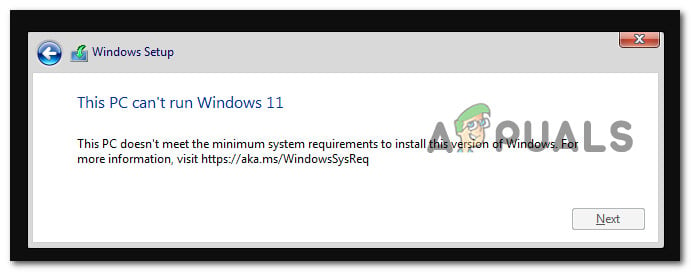
After looking into his issue thoroughly, we realized that there are actually multiple potential causes why this issue will occur. Even though the underlying message will most likely hit that your PC is not meeting the minimum requirements, you’ll see that this is not always the case. To make matters easier for you, we’ve put together a list of potential culprits that are most likely responsible for this issue:
- Minimum Windows 11 requirements are not met – The first thing you should do in case you’re experiencing this issue is to make sure that you are actually meeting the minimum Windows 11 requirements. While there are ways to bypass the Secure Boot and TPM 2.0 requirements, you need to make sure that you have enough space on the OS drive and that your processor is supported for Windows 11.
- Secure Boot and TPM 2.0 is disabled inside VMware Workstation – Another reason why you might be experiencing this issue is if Secure Boot and TPM 2.0 is actually supported by your system but the two features are disabled inside the Virtual Machine settings of VMware Workstation. In order to fix this issue, all you need to do is Enable secure boot from the Fireware section and Trusted Platform Module from the Trusted Platform Module.
- VTPM is not added in VMware workstation – Another reason why you can expect to deal with this issue is a scenario in which the VTPM file is not correctly configured to accommodate a Windows 11 virtual machine. In this case, you can fix the issue by editing the VMX file in order to ensure that VTPM is added to in VMware Workstation.
- TPM Check fails – If you pass every other requirement except the TPM check, you can easily get around it by modifying a Registry entry that is responsible for performing a TPM check inside VMware Workstation. To fix this problem, you’ll need to do some editing via an elevated Command prompt.
Now that you are familiar with every potential cause of this issue, let’s get to the fixing part. Below you’ll find a list of fixes that other affected users have successfully used to get to the bottom of this issue.
1. Meet the minimum requirements
If you’re just beginning to troubleshoot the ‘This PC can’t run Windows 11‘ error with WMware Workstation, the first thing you need to do is ensure that your current PC setup meets the minimum requirements:
- The system disk needs to be 64GB or larger
- The processor isn’t supported for Windows 11 – 1 gigahertz (GHz) or faster with 2 or more cores on a compatible 64-bit processor or System on a Chip (SoC)
- The PC must support Secure Boot
- The PC must support TPM 2.0
- TPM2.0 must be enabled
Note: While the TPM 2.0 and Secure Boot requirements can be bypassed with a few workarounds that we will show below, the other ones are mandatory. So before proceeding with the next methods below, make sure that you meet the free disk space and processor requirements.
Once you’ve made sure that you’re meeting the minimum requirements, move down to the next method below.
2. Enable Secure Boot and TPM 2.0 on VMware
The most typical cause of this problem is that your system supports Secure Boot and TPM 2.0, yet the two capabilities are deactivated in VMware Workstation’s Virtual Machine settings. Simply enable secure boot from the Fireware section and Trusted Platform Module from the Trusted Platform Module to resolve this issue.
You can repair the error by encrypting your virtual machine and then adding a virtual Trusted Platform Module (TPM) if you use VMware Workstation Pro.
Important: If you’re using VMware Workstation Player, move on to the next technique, which involves a registry hack and modifying the .vmx file.
The instructions below we’re only tested on VMware Workstation Pro. To encrypt and add TPM to your virtual system, follow these steps:
- To begin, open your installed VMware Workstation PRO version.
Note: If you haven’t previously done so, create a new virtual computer. - Then Select Settings by selecting and right-clicking on your virtual machine.
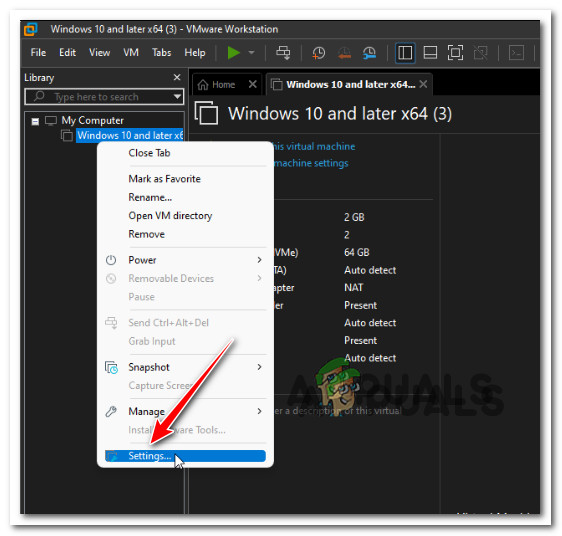
Accessing the Settings menu - Next, open the Options tab in the Settings window.
- Select the Access Control tab from the left pane.
- Next, move over to the right pane and click on the Encrypt button.
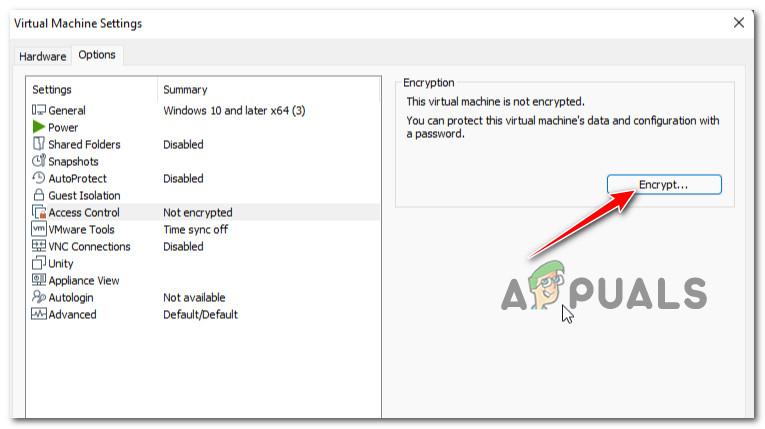
Click on the Encrypt button from the right-hand side - From the next screen, enter an encryption password and confirm it a second time.
Note: You’ll need the encryption password to access the virtual machine, so keep it safe. - Wait for the encryption procedure to finish before clicking the Encrypt button.
- When you’re finished, click OK to save your changes.
- At this point, TPM can now be installed on your virtual system. To do so, select Settings from the context menu of your encrypted virtual machine.
- Click the Add button on the Hardware tab.
- In the Hardware Type window, choose Trusted Platform Module.

Access the Trusted Platform Module - To add virtual TPM to your virtual computer, click the Finish button.
- In the Summary column of the Settings window, the Trusted Platform Module will be marked as Present.
- To save the changes, click OK.
- Attempt to perform the installation of WIndows 11 inside VMware and see if the problem is now fixed.
If the problem is still not fixed, move down to the next method below.
3. Edit the VMX File to Add VTPM
A scenario in which the VTPM file is not correctly set to accept a Windows 11 virtual machine is another reason you can encounter this problem. In this situation, you can resolve the problem by modifying the VMX file to verify that VTPM is installed in VMware Workstation.
Editing your virtual machine’s .vmx file and adding the VTPM is the simplest solution to fix the PC can’t run Windows 11 issue (Virtual Trusted Platform Module). This solution works with all VMware Workstation versions, including Pro, Player, and Fusion.
To make use of the software feature by altering the .vmx file, follow these steps:
- To begin, open VMware Workstation.
Note: If you don’t already have one, make a new virtual machine. Also, turn off any virtual machines that are currently active. - Select Settings from the context menu of your virtual machine by right-clicking it.
In the Settings window, click the Options tab.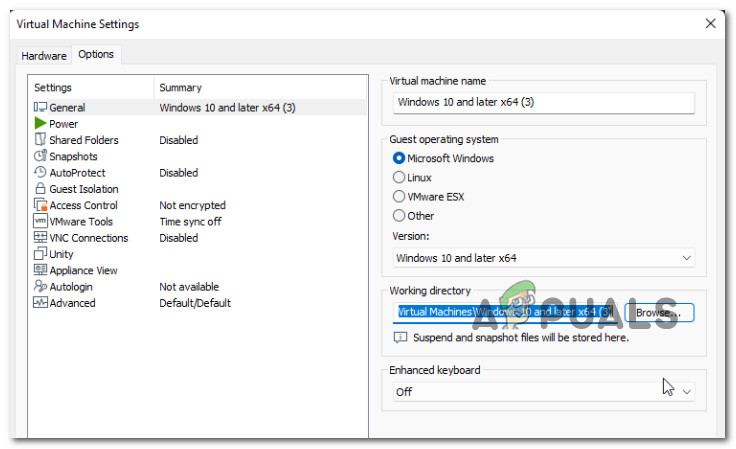
Accessing the Options tab - Locate the Working directory in the right pane.
- This is where your virtual machine’s .vmx file is stored. As a result, copy the path to the working directory to your clipboard.
- To close the Settings window, click OK.
- To open File Explorer, press Win + E and go to the working directory path. Depending on where you want to install the virtual machine, the path may change.
- The path to the default working directory looks like this:
C:\Users\UserName\Documents\Virtual Machines\Windows 10 or Windows 11
- Locate the Windows 10 and Later x64.vmx file in the Windows 10 and Later x64 folder.
- From the next menu, select Open With > Notepad from the context menu when you right-click on the .vmx file.
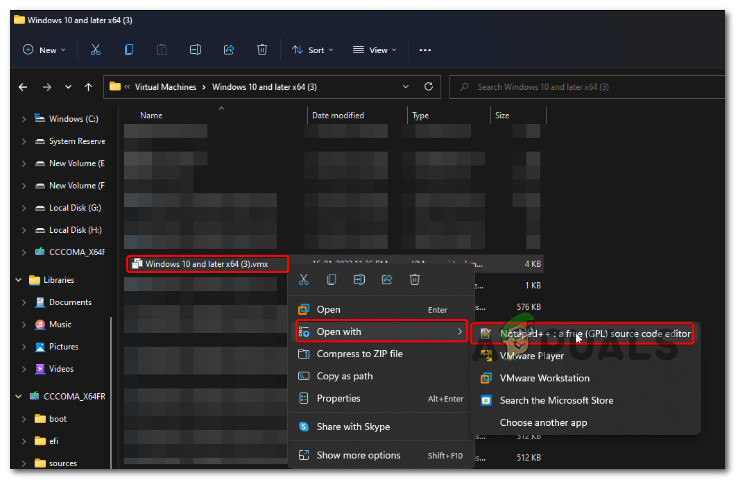
Opening with Notepad Note: Other text editors, such as Notepad++, can also be used.
- Add the following line to the end of the file when it opens in Notepad:
autoAddVTPM = "software" managedVM.autoAddVTPM = "software"
- To save the file and close Notepad, use Ctrl + S.
- Restart VMware Workstation, Fusion, or Player once the file has been edited.
- Restart your virtual computer and proceed with the Windows 11 installation. You should be able to skip the TPM check and finish the installation.
If the problem is still not resolved, move to the final potential fix below.
4. Bypass TPM Check for VMware via Registry Editor
If you meet all of the other requirements except the TPM check, you may easily bypass it by changing a Registry entry that is responsible for executing a TPM check inside VMware Workstation. To resolve this issue, you’ll need to use an elevated Command prompt to make certain changes.
Another option for resolving this issue is to edit the Windows registry and add new entries. It will assist you in overcoming the VMware Workstation minimum system requirement error.
When the system requirement notification displays on your screen, this approach entails editing and inserting a registry item.
Here’s how to do this:
- Install Windows 11 on your virtual machine after you’ve set it up.
- The ‘This PC can’t run Windows 11‘ issue blocks the Windows setup due to missing system requirements when installing Windows 11 in VMware Workstation.
- To open the Command Prompt, hit Shift + F10 on your keyboard when the following error message occurs.

Opening Regedit - To open Registry Editor, execute the following command in the Command Prompt window and click Enter:
regedit
- Navigate to the following place in the Registry Editor:
HKEY_LOCAL_MACHINE\SYSTEM\Setup
- Select New > Key from the context menu of the Setup key.

Tweaking the new setup - BypassTPMCheck should be renamed to the key.
- Select New > DWORD (32-bit) value from the context menu of the BypassTPMCheck key.

Bypass TPM checks - LabConfig should be renamed to the new DWORD value.
- Modify the LabConfig value by right-clicking on it.
- To save the changes, type 1 in the Value data field and click OK.

Creating the Labconfig value - Close the Registry Editor when you’re finished.
- To exit the Command Prompt, type exit and hit Enter.
- With this PC can’t run error, you’ll be back in the Windows Setup window. In the top left corner, click the Back button (back arrow icon).
- Click Next after selecting the Windows edition you want to install.
- You should now be able to complete the Windows 11 setup without encountering any errors.





